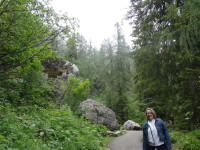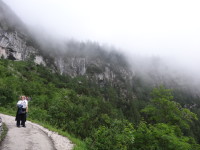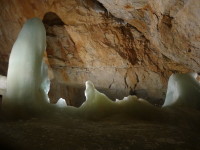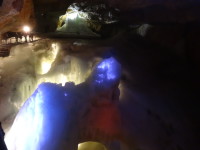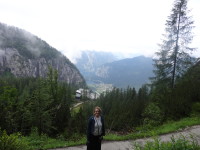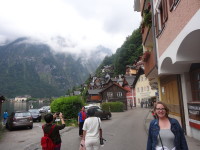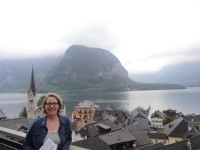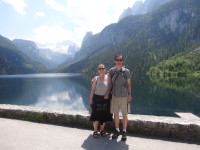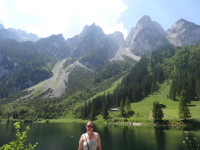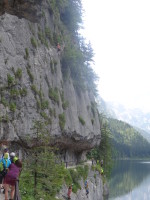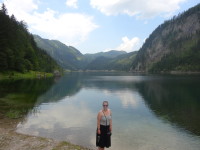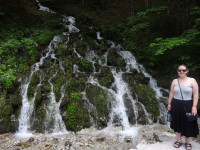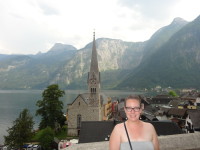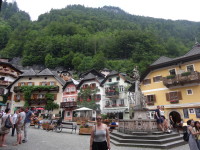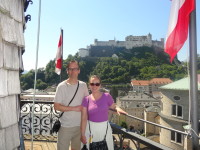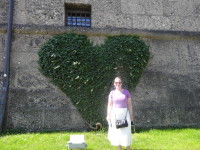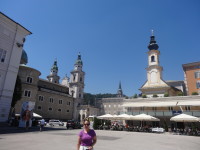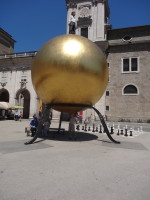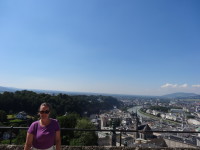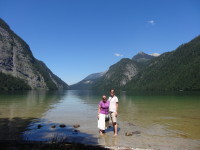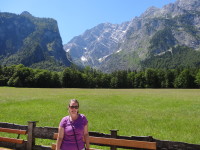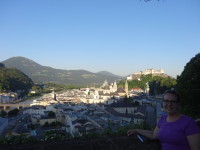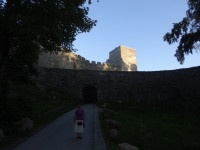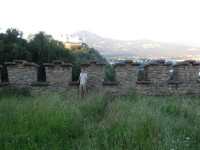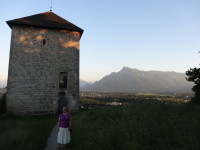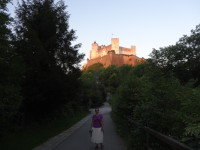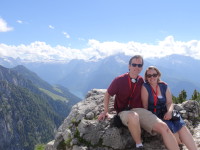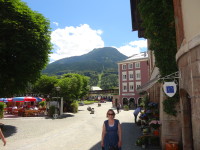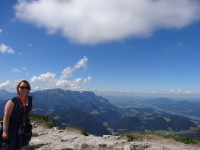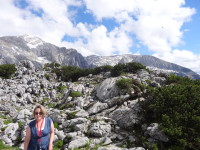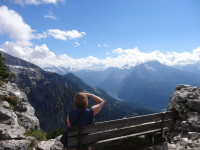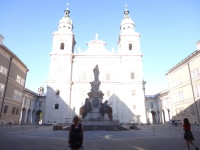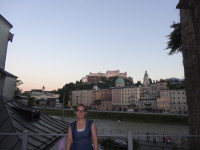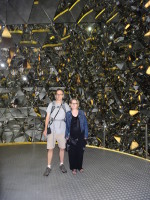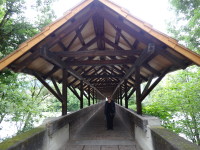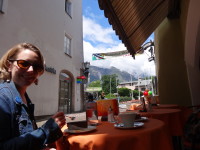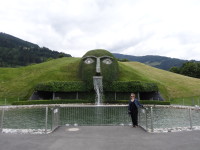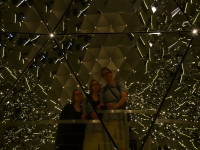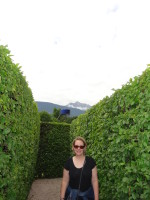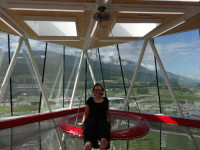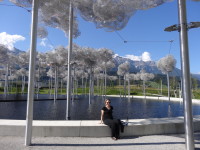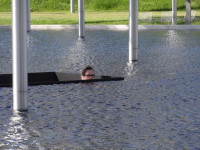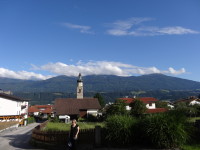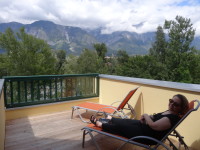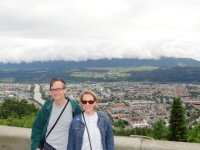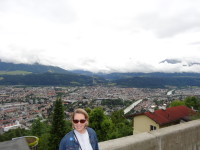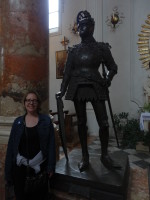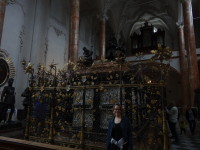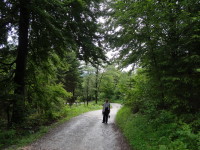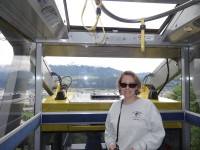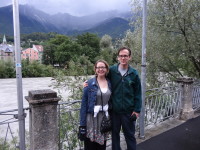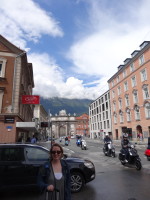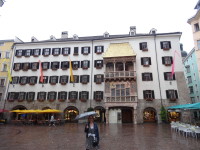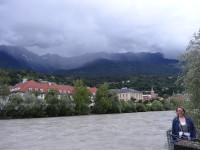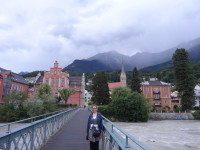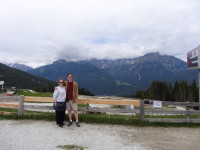 We got off to a later start this morning; we slept in until 8:00, and after breakfast, I had to do internet research on what to do with the day. The problem with Tirol is that is has a ton of worthwhile things to do, so I had to narrow it down a bit. We finally got underway around 10:45.
We got off to a later start this morning; we slept in until 8:00, and after breakfast, I had to do internet research on what to do with the day. The problem with Tirol is that is has a ton of worthwhile things to do, so I had to narrow it down a bit. We finally got underway around 10:45.
We first headed west to Mieders, a small town in a valley surrounded by mountains, one of which has a glacier on it — very much still snow-capped in June. We were there to ride the Alpine slide/toboggan. It has the self-claim of being the steepest track in the Alps, and while not the longest, it is nothing to sneer at at 2.8 km long (about 1.7 miles). We arrived and were told that we had to wait for thirty minutes for the track to dry from the overnight rain. We still bought two-ride ticktes (Mer had remembered they are cheaper that way). We discovered while riding a much-shorter slide last year in Slovenia that you want two rides — one to see how the track goes and to take it easy for seeing the sights, and one for speed.
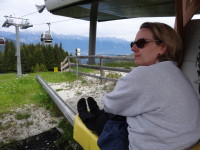 We passed the time chatting with a grandmother from Virginia and her husband from England and their granddaughter from Kansas City. They were very nice, and after about a half hour, the track opened. We rode up the fairly fast gondola with a German couple who were driving about Europe in an RV.
We passed the time chatting with a grandmother from Virginia and her husband from England and their granddaughter from Kansas City. They were very nice, and after about a half hour, the track opened. We rode up the fairly fast gondola with a German couple who were driving about Europe in an RV.
When we got to the top, we got in the short line for the toboggan, and had a few minutes to enjoy the scenery. The mountains here were spectacular, and could be seen easily, since the morning clouds were starting to break up. After a few minutes of quiet contemplation, it was show time!
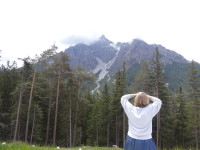 Mer went first, and about 30 seconds later I got to go. What a rush. It is a beautiful, amazing, fast, wild ride. You control your own speed on a toboggan, as long as you do not hit the person in front. We both could take it easy along good sections of the track, and then let it run free on some of the steep drops. The track went into a dense forest area, and the temperature dropped and you could smell the trees, all while whizzing along. Even the fastest rider takes over four minutes to get to the bottom, and most riders take longer than that.
Mer went first, and about 30 seconds later I got to go. What a rush. It is a beautiful, amazing, fast, wild ride. You control your own speed on a toboggan, as long as you do not hit the person in front. We both could take it easy along good sections of the track, and then let it run free on some of the steep drops. The track went into a dense forest area, and the temperature dropped and you could smell the trees, all while whizzing along. Even the fastest rider takes over four minutes to get to the bottom, and most riders take longer than that.
We both had successful first rides, and jumped right back on the gondola, which we shared with one quiet German man. When we got to the top, we took time to sit on a deck chair and enjoy the beauty around us. We wandered around a couple of small man-made ponds on a trail, mostly to see the mountains from different angles — you could even just catch a glimpse of the side of the glacier a couple of mountains away. We took our time walking, and then headed back for the speed run.
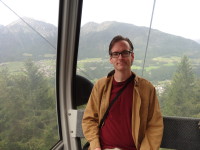 Which turned out to be just okay. I don’t know if it was the sleds we got on, or if they are all like that, but mine did not feel like it was running free (clear of the brake). Even when I had the speed control all the way forward, it felt like something was dragging. I did the entire run at full speed and never felt like I had to brake until the last three very sharp turns. It was still a fun run, but not quite the heart-pounding speed I had hoped for. Mer said hers was the same way. I kicked around buying one more ticket to see if it was a fluke, but the tickets were not cheap and I was afraid we would get the same experience again. It was still a ton of fun, and as Meredith pointed out, we’d gotten to ride Alpine slides in the actual Alps.
Which turned out to be just okay. I don’t know if it was the sleds we got on, or if they are all like that, but mine did not feel like it was running free (clear of the brake). Even when I had the speed control all the way forward, it felt like something was dragging. I did the entire run at full speed and never felt like I had to brake until the last three very sharp turns. It was still a fun run, but not quite the heart-pounding speed I had hoped for. Mer said hers was the same way. I kicked around buying one more ticket to see if it was a fluke, but the tickets were not cheap and I was afraid we would get the same experience again. It was still a ton of fun, and as Meredith pointed out, we’d gotten to ride Alpine slides in the actual Alps.
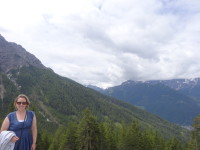 We jumped back in the car and drove west to the town of Rattenberg. I had seen on a Tirol tourism site that Rattenberg was known for glass blowing, and had live demonstrations. I love decorative glass, so away we went.
We jumped back in the car and drove west to the town of Rattenberg. I had seen on a Tirol tourism site that Rattenberg was known for glass blowing, and had live demonstrations. I love decorative glass, so away we went.
We got to “the smallest town in Austria” (according to the map I picked up) and I was delighted to see it had some castle ruins, and it had another site I had seen online but had not realized was in the same town — the Augustiner Museum. It is a Christian artifact and art museum in an old Augustine monastery. Plus, we found out from the brochure, the four-euro ticket got you entrance to the church attic and the bell tower — the only such climbs you can make in a working church in Austria. We went there first.
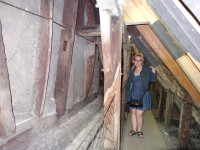 Since Mer and I both love religious art and history, the place was amazing. Despite the tour buses that crammed into the main street of the town to buy up glass, we had this museum in a back corner of town all to ourselves. There were tons of paintings from the 14th and 15th centuries (the monastery was built in the late 1300s). Mer pointed out that this random little museum in a dinky town had a collection that would make the core of a great regional museum back home. It is good to be a European Catholic church — you have old things.
Since Mer and I both love religious art and history, the place was amazing. Despite the tour buses that crammed into the main street of the town to buy up glass, we had this museum in a back corner of town all to ourselves. There were tons of paintings from the 14th and 15th centuries (the monastery was built in the late 1300s). Mer pointed out that this random little museum in a dinky town had a collection that would make the core of a great regional museum back home. It is good to be a European Catholic church — you have old things.
One altar had a jointed Jesus on it so he could move for Passion Week plays — we had never seen anything like that. The figure could even move its tongue. There were some very striking paintings covering four hundred years, and it was nice to be able to compare the styles and how they changed.
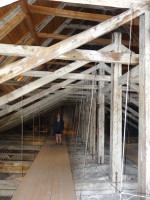 The treasury room held gold and silver vessels for church services, including crosses, host containers (for the wafers for communion), silver book covers, and more. Again, a little town, which, granted, used to be very wealthy, has a room full of silver and gold objects, most of which were two hundred years old or older. Amazing.
The treasury room held gold and silver vessels for church services, including crosses, host containers (for the wafers for communion), silver book covers, and more. Again, a little town, which, granted, used to be very wealthy, has a room full of silver and gold objects, most of which were two hundred years old or older. Amazing.
We looked in the elaborately decorated church, and then went through the second floor of exhibits, and then we climbed up to the attic. The attic was an attic — it was full of more old figures and art. That was good in its way, but what was amazing to us was we could climb up over the ceiling of the church, between the ceiling and the real roof. We got to see all the structure that held the ceiling up; since the ceiling was mostly plaster, it could not support its own weight, so there were beams holding the ceiling up, quite separate from the beams holding the roof up. You could walk all around the entire area and even see the superstructure of the main dome. Very, very cool.
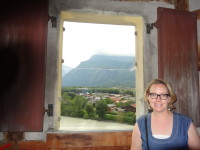 Then we climbed all the way up through the bell tower, to a level one level above the bell (no one knows exactly why there was an additional level). Interestingly, the bell tower was made of timber and not stone because it was added on to the existing abbey, and so the usual massive foundation could not be set up. We got to the see the old clock mechanism (the clock itself was removed in a renovation in the 1800s) and the old bells. The views from the top of the tower were excellent, and I did not freak out too badly (I’m scared of heights). We climbed down and looked on one more room of items we had missed, and then left the museum. That was eight euros very well spent.
Then we climbed all the way up through the bell tower, to a level one level above the bell (no one knows exactly why there was an additional level). Interestingly, the bell tower was made of timber and not stone because it was added on to the existing abbey, and so the usual massive foundation could not be set up. We got to the see the old clock mechanism (the clock itself was removed in a renovation in the 1800s) and the old bells. The views from the top of the tower were excellent, and I did not freak out too badly (I’m scared of heights). We climbed down and looked on one more room of items we had missed, and then left the museum. That was eight euros very well spent.
The town of Rattenberg is very cute, built between a cliff and the Inn River. As such, the layout of the town is much the same as it has been for hundreds of years. Some glass companies opened stores here around 1900, and it has since become a center of glass objects and art. The only downside was the town was overrun by tourists — the town is a stop for some tour buses, and so it was more crowded that I would have wished.
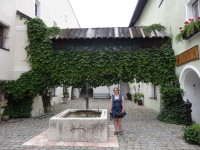 We ducked into the main glass store I had wanted to see, where they have live glass blowing. The place was amazing — I have never seen so much fine glass artwork, and never in so many styles and colors. We watched a glass blower work for a few minutes before I decided to check out a small opening in the wall. It led to an artificial cave full of thematically arranged glass objects. That “cave” led to another “cave” of glass art, and that “cave” led to a REAL cave. The real cave was damp and cool, and the glass company (Schauglasblaserei) had set up an open-air cabin in it, with two dummies (a man and a woman) sitting at a table with place settings and roses all made of glass. It was not what we were expecting at all. We made our way back out of the cave and the store and into the street. I wanted to check out the castle.
We ducked into the main glass store I had wanted to see, where they have live glass blowing. The place was amazing — I have never seen so much fine glass artwork, and never in so many styles and colors. We watched a glass blower work for a few minutes before I decided to check out a small opening in the wall. It led to an artificial cave full of thematically arranged glass objects. That “cave” led to another “cave” of glass art, and that “cave” led to a REAL cave. The real cave was damp and cool, and the glass company (Schauglasblaserei) had set up an open-air cabin in it, with two dummies (a man and a woman) sitting at a table with place settings and roses all made of glass. It was not what we were expecting at all. We made our way back out of the cave and the store and into the street. I wanted to check out the castle.
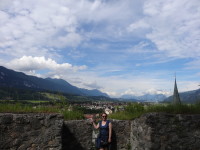 You can walk up to the castle, and it is of course up. We huffed our way up to the top, where we had great views of the Inn valley, the town, and the surrounding mountains. The keep of the castle, which seems to be intact, was locked up, which was disappointing. We rested a bit at the top, and took an easier way back to town. To finish up our visit to Rattenberg, we walked along the paved trail along the Inn (it seems as if Austrians have paved trails along every river, which is amazing).
You can walk up to the castle, and it is of course up. We huffed our way up to the top, where we had great views of the Inn valley, the town, and the surrounding mountains. The keep of the castle, which seems to be intact, was locked up, which was disappointing. We rested a bit at the top, and took an easier way back to town. To finish up our visit to Rattenberg, we walked along the paved trail along the Inn (it seems as if Austrians have paved trails along every river, which is amazing).
Back at the car, I got us back on the highway going west back toward Hall, but I got off at Wattens (home of the barfing giant, as you may remember). We kept going, and then up, and up, and up, until we reached Wattenberg at 3,280 feet. I wanted to have supper here, and was surprised to not find a small village as I had envisioned, but a scattering of buildings. We stopped next to what turned out to be a restaurant, but they were closed. A man there told us in broken English to “go 500 meters, left, then down!” We did that, and we found Gasthof Sage, a restaurant next to an unexpected soccer pitch and basketball court.
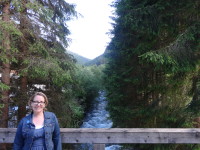 We went in, and were told, in very limited English, that it was a special evening, and they would have to check to see if they could seat us. They did, and we sat. The special evening was that the restaurant was only serving a traditional area food called krapfen. We had no idea what that was, but we were hungry and charmed at finding something so far off the beaten tourist path, so we said we would try it. It turned out to be a fried turnover stuffed with potato and cheese. You bought them piecemeal, and so Mer and I each had five with the understanding that we would have a second supper back at the hotel so that our only supper would not consist of only fried pastry.
We went in, and were told, in very limited English, that it was a special evening, and they would have to check to see if they could seat us. They did, and we sat. The special evening was that the restaurant was only serving a traditional area food called krapfen. We had no idea what that was, but we were hungry and charmed at finding something so far off the beaten tourist path, so we said we would try it. It turned out to be a fried turnover stuffed with potato and cheese. You bought them piecemeal, and so Mer and I each had five with the understanding that we would have a second supper back at the hotel so that our only supper would not consist of only fried pastry.
That was a great travel experience, and the servers were very patient with their limited English and our nonexistent German. We drove back home, and I even managed to look away from the winding downhill road once or twice to see the amazing views around us. Then I looked back at the road, which was too narrow and too steep for my liking.
Happily, by then we had found out the name of the dish. So, when we were at a narrow place in the road with an oncoming car and pedestrians on the side of the road, I got to mutter, “Get the krapfen out of my way!” Several other witty remarks like that were made during the evening, because our humor is both juvenile AND culturally insensitive.
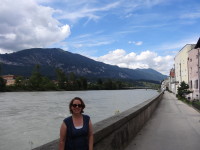 We got back to the hotel, tired after a long day, and we did eat a second supper in the hotel restaurant. That left us in good shape to go back to the room and take it easy. Mer and I split time “being in charge” on vacation, and after four days of my saying what we should do, I hand the authority over to Meredith for the next six days. This head will not miss the crown for awhile — it is hard trying not to screw up. Happily, the last four days went well, even with some rain. Here is to Mer having even better success!
We got back to the hotel, tired after a long day, and we did eat a second supper in the hotel restaurant. That left us in good shape to go back to the room and take it easy. Mer and I split time “being in charge” on vacation, and after four days of my saying what we should do, I hand the authority over to Meredith for the next six days. This head will not miss the crown for awhile — it is hard trying not to screw up. Happily, the last four days went well, even with some rain. Here is to Mer having even better success!
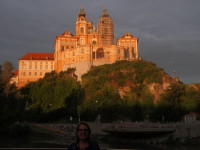 So, after nine days of being in Alpine country, we finally left the mountains behind, heading east toward our eventual destination of Melk, home of a huge (and I do mean huge) abbey. We started off the day in a light but steady rain, but we had a two-hour drive ahead of us, and the rain did stop just as we pulled into our main destination of the day, Mauthausen concentration camp.
So, after nine days of being in Alpine country, we finally left the mountains behind, heading east toward our eventual destination of Melk, home of a huge (and I do mean huge) abbey. We started off the day in a light but steady rain, but we had a two-hour drive ahead of us, and the rain did stop just as we pulled into our main destination of the day, Mauthausen concentration camp.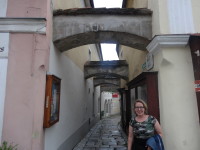 We continued on our way to Melk, getting to our hotel in the evening around 6:30. That left little time for more than supper, although we did sneak in a short walk down to the surprisingly small Danube River. We walked along it for a short ways, stopping by a store to grab some European candy bars before heading back to the hotel.
We continued on our way to Melk, getting to our hotel in the evening around 6:30. That left little time for more than supper, although we did sneak in a short walk down to the surprisingly small Danube River. We walked along it for a short ways, stopping by a store to grab some European candy bars before heading back to the hotel.